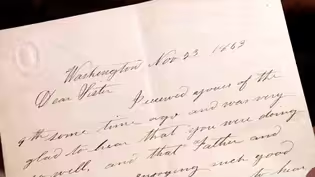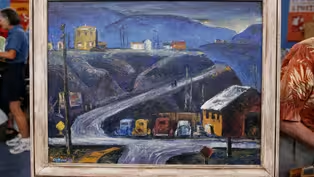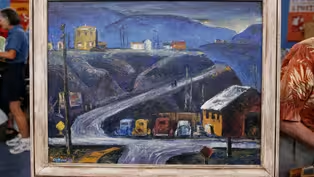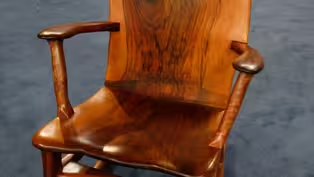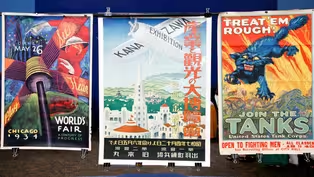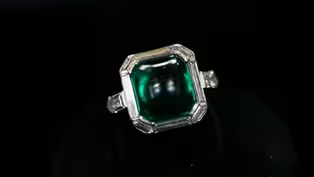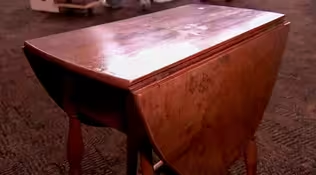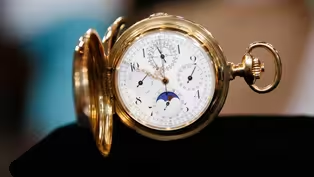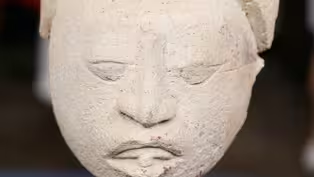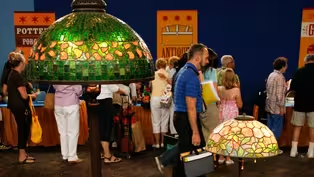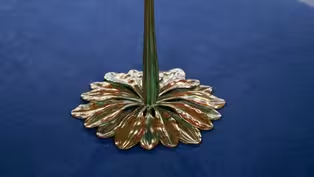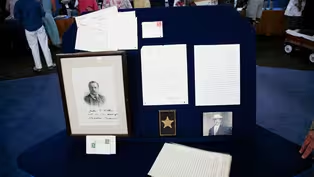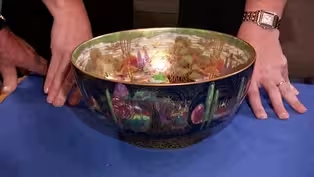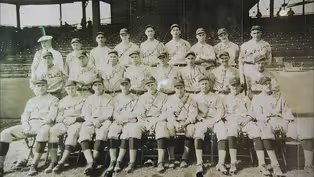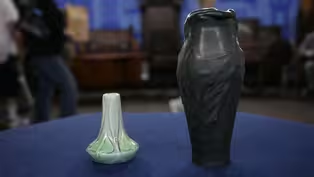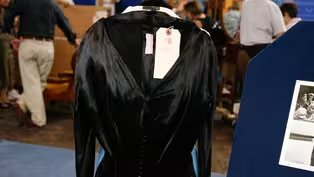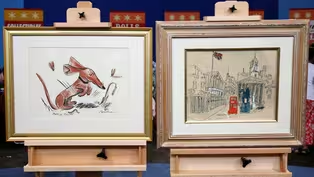
Vintage Palm Springs, Hour 1
Season 26 Episode 16 | 52m 30sVideo has Closed Captions
Head back to Palm Springs for sizzling finds, like an updated appraisal of $400K to $600K!
Journey back to Palm Springs for sizzling finds, including Tiffany Studios lamps, an Art Deco emerald diamond ring, ca. 1930, and a Some Like It Hot Marilyn Monroe dress. Guess which find has an updated value of $400,000 to $600,000!
Problems playing video? | Closed Captioning Feedback
Problems playing video? | Closed Captioning Feedback
Funding for ANTIQUES ROADSHOW is provided by Ancestry and American Cruise Lines. Additional funding is provided by public television viewers.

Vintage Palm Springs, Hour 1
Season 26 Episode 16 | 52m 30sVideo has Closed Captions
Journey back to Palm Springs for sizzling finds, including Tiffany Studios lamps, an Art Deco emerald diamond ring, ca. 1930, and a Some Like It Hot Marilyn Monroe dress. Guess which find has an updated value of $400,000 to $600,000!
Problems playing video? | Closed Captioning Feedback
How to Watch Antiques Roadshow
Antiques Roadshow is available to stream on pbs.org and the free PBS App, available on iPhone, Apple TV, Android TV, Android smartphones, Amazon Fire TV, Amazon Fire Tablet, Roku, Samsung Smart TV, and Vizio.
Buy Now
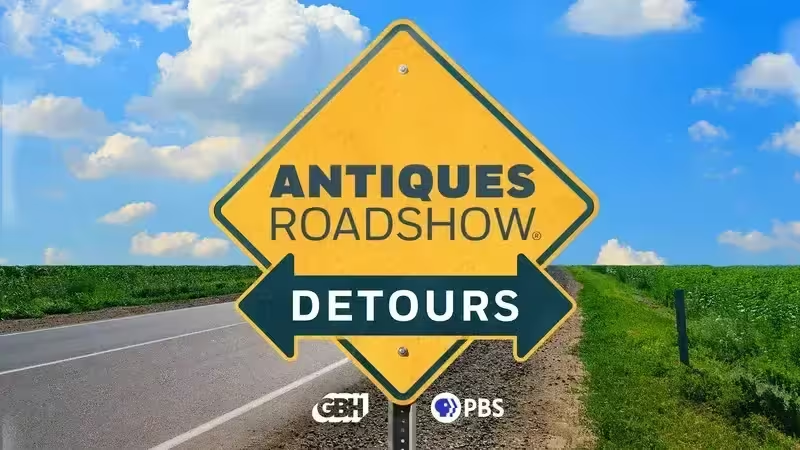
ANTIQUES ROADSHOW DETOURS
Ever wondered what happens to the treasures featured on America’s beloved ANTIQUES ROADSHOW after the cameras leave town? Host Adam Monahan tracks down the juicy afterlives of your favorite finds from PBS’s hit series.Providing Support for PBS.org
Learn Moreabout PBS online sponsorship♪ I will trade you the estimate if you let me wear your hat.
(laughs) Whoa!
APPRAISER: Yes.
Oh, my gosh!
I tip my hat to you, sir.
No, no, you tip my hat to me!
I tip your hat to you, sir.
(laughs) ♪ CORAL PEÑA: In 2008, we visited Hollywood's playground, Palm Springs, California.
APPRAISER: This is an iconic dress from an iconic film.
PEÑA: It did not disappoint when we discovered Marilyn Monroe's dress from "Some Like It Hot."
APPRAISER: Worn by one of the greatest sex symbols of the 20th century.
PEÑA: Has the value of this silky stunner cooled off?
Or is it still sizzling?
Oh, my... (laughs) Whoa!
PEÑA: Find out which blockbuster finds went up... Oh, my God, I, I owe him a big dinner in Paris!
(laughs) PEÑA: ...down... APPRAISER: And I'm telling you that just so we can learn from it, you know?
Ah, jeez.
PEÑA: ...or stayed the same... APPRAISER: I have to say, in all my years on the "Roadshow," it's probably the most exciting find I've had.
Oh, really?
And I'm absolutely thrilled that you brought it in today.
PEÑA: ...in this first hour of "Vintage Palm Springs."
They belonged to a good friend of mine who passed away, uh, three years ago, in 2005, and he left them to me.
And what did he tell you about them?
He told me that they were Tiffany, and that the floor lamp was originally in New York, I think, in the '40s, and then he moved to Chicago in the '50s and, and the '60s, and then he moved to Los Angeles until 1988, and then he moved to Palm Springs.
That one he bought in Los Angeles.
Okay, and do you know when?
Burbank.
I would say probably '73.
'74, maybe.
1973.
What's interesting to see when someone collects lamps... Yeah.
...is that people prefer a certain style.
And with these Tiffany Studios lamps-- and yes, they are Tiffany Studios lamps-- both of these are lamps, or what I would call geometric lamps, but they have a little bit of decoration-- they're a combination.
You have a geometric background on the larger lamp, and then you have the decoration through here.
These are what we call the woodbine pattern.
And then the floor lamp, that pattern, we have a number of names for that.
It's called swirling leaf, swirling lemon leaf, or lemon leaf.
Okay.
I'm not exactly sure what Tiffany called it.
Uh-huh.
I actually think that both of these lamps are on the early side, circa 1905.
One of the reasons why is that the big shade, the glass is a very transparent glass.
And at the time, when people were first using electricity, or even using fuel, in order to get any light, the glass had to be very transparent.
This lamp I also think is early.
The reason I know that is-- I'm going to take the cap off, or the heat finial, some people call it that, also.
The signature says Tiffany Studios, New York.
It then bears a number with a dash-- in the old days, certain people had speculated that that meant that the shade was a special order.
But now scholars are tending to believe that it meant that it's an early lamp.
This has particularly beautiful, beautiful glass in it, as does that lamp.
I'm going to put this down for a second.
And I just want to point out, clearly, these sockets have been replaced.
Yes.
A while ago, but nevertheless, they're not original Tiffany sockets.
The other thing is, on both of these lamps, a lot of times these get lost, but these are the originals, which is a very nice bonus to have.
And even the, the original caps have a lot of value today.
Really?
On this lamp, it's on a senior floor base, it's decorated.
There were two kinds of decorated senior floor bases.
There's this one, and then there was a pod-decorated base.
That one's a little more desirable, but there's nothing wrong with this.
It has wonderful finish on it.
It matches this shade beautifully.
And I also wanted to point out this little signature tag here.
Yes.
That's an, actually a very early tag, also.
A lamp like this, I would recommend putting an insurance value of $85,000.
And on this one, I would put an insurance value of $45,000.
Okay.
They're both very nice examples, and I am delighted to see them.
Great.
MAN: I first remember seeing them when I was about eight or ten years old.
I was really intrigued by the woman across the top of the, the vase.
It was very, very unique.
My mother's grandmother lived next door to Harry Bangs, who was an assistant to Artus Van Briggle.
And when a similar piece apparently won a prize in the Paris Art Show, Mr. Bangs was given this piece.
Later on, his wife was going through having a child, and she passed away.
And the grandmother took care of the child until relatives could step in, and in appreciation, she was given this piece.
So it's been in the family since sometime in the early 1900s.
That's great provenance, and they didn't just give you a couple of pieces, they gave you a couple of very special pieces.
And let's start with this one first.
It's a little piece of Van Briggle.
It's a nice early one.
It's got Van Briggle's mark on it, it's dated 1902, there are Roman numeral threes for the clay composition.
The double-A mark is for Artus and Anna.
They're molded pieces.
This one's particularly special-- number one, while it's a molded piece, you can see that it's sharpened up after the mold.
So this embossed detailing is very crisp.
But on top of that, this glazing is really bright.
This is sang de boeuf, or blood of ox, running through it.
So in addition to having two distinctly different shades of green, there's some oxblood running through it, as well, too.
This is a sweet little piece of Van Briggle.
I mean, just a charming cabinet piece.
This thing, this is as good as it gets, I mean... (laughs) Artus was dying of tuberculosis.
Right.
He was in love with his wife, Anna.
This is a tribute piece.
This piece is created out of his love for her.
It's a, a woman in repose wrapped around the top of the pot.
There's a, a certain sadness and a certain amount of resignation involved with, with designing and, and conceiving of this piece.
And it's considered to be one of the standard-bearing pieces of American decorative ceramics from the Arts and Crafts, Art Nouveau period.
They're still making this.
That's how enduring the design is.
But this 1902 version is the most mature version of his work.
There are earlier ones which are germinal.
Right.
There are later ones which are interesting, but the 1902 Lorelei is the best interpretation of this design.
On top of that, and this is what I really love about this piece, this is the glaze he was trying to achieve.
The perfect dead-matte, spinach green finish.
Great!
And that's what this has.
And I like the way that it flows unevenly around the side of the pot.
Here's, by the way, as her leg comes down...
Right.
...that's her heel sticking out of the piece.
Right.
It's an early version of the mold, so the design is very crisp, in addition to whatever sharpening he did afterwards.
It's very clearly marked.
Again, the double-A mark, 1902.
This you might think is a damage, but really, it's a little stilt pull that's been ground down at the factory by Van Briggle.
So both pieces flawless, both pieces exquisite.
I'm so happy to see them.
Mm!
In terms of value, these have sold for about $2,500 at auction.
I like this one better-- I would expect this to bring maybe double that, $4,000 to $5,000.
I've seen one of the Lorelei of this quality, and it's got a big hairline crack running through it.
This is probably the best Van Briggle Lorelei there is.
Hm...
In my opinion, this is worth, at auction, between $50,000 and $60,000.
Hm.
That's impressive.
(laughs) Well, believe me, it's, uh, no small thing.
We'll take care of it.
Yeah, by all means, do.
APPRAISER: It's a typical bar pin from the 1920s.
It has a tube hinge, which tells me it's from Europe.
Now, the surprising thing is, you can take this pin and you squish it in the middle, and you put a flower in there, and that's how you wear the pin.
It's worth about $5,000.
You're kidding!
On a retail level, in a nice store... Wow!
...$5,000.
Oh, my.
WOMAN: I have brought a photograph of the 1924 Washington Senators, who won the World Series that year.
My father was Earl McNeely... APPRAISER: Okay.
...who played outfield.
The series went seven games, and he was lucky enough to drive in the winning run of the seventh game in the 12th inning.
So here's your father with great company.
Hall-of-Famer Goose Goslin, Sam Rice, Bucky Harris, and the superstar pitcher Walter Johnson.
Right.
Consequently, what, what was your father awarded for, for his triumph, his World Series triumph?
I think it was maybe $50,000.
Along with this pendant, right?
Yes, yes.
Today, we see these lavish rings covered in diamonds.
And here we have the old way of showing recognition of winning a, a world championship, as regal as, as it should be.
Two significant items of baseball memorabilia that, at auction, together, would sell for $10,000 easily.
Oh, Dad must be rotating rapidly in his grave at that point.
(laughs) WOMAN: It's a inherited family heirloom from my mother-in-law.
I opened the box with this, and it was such a gorgeous emerald.
I mean, it just really caught my eye, and I've been wearing it.
I love it.
And, um, I'm very fortunate that my husband is an only child, because he, he can't wear it!
(laughs) Have you ever had it appraised?
Do you have any idea of the type of value this...
I did, we had to have it appraised for the estate when she passed away.
Estate.
And that appraisal-- if I remember, it was in 1991-- was, like, $15,000.
Mm-hmm.
And, uh, of course the appraiser, he was so taken with it, he said the diamond baguettes were unusually long.
Right.
And he said, "Boy, I'd love to have that and take it apart and whittle it into little pieces."
(laughs): And I said, "There is no way I could ever, ever allow that to happen to that piece."
Well, I'm glad you didn't have him take the ring apart.
Oh, no.
A little bit about the ring.
It's a beautiful, beautiful example of Art Deco jewelry.
Mm-hmm.
And it would be from the 1920s-1930s.
It also has a quintessential center stone in terms of the shape.
It's what is called a sugarloaf cut.
So it's like a four-sided pyramid that's like a big dome.
And this has been done to maximize the color of the emerald.
Mm-hmm.
The other beautiful aspect, apart from the incredible color this stone has, is, as you mentioned, there are these beautiful baguettes on the side.
These are what are called bullet shapes, 'cause they're pointed at one end.
Mm-hmm.
There are rectangular baguettes here.
But the real detail that I think is quite extraordinary is where they've put these beautiful hexagonal-cut diamonds.
And once again, you can see that it has this beautiful dome.
It reflects the quality of the green.
And this really is a true emerald green.
We really can't tell where it was made.
There are no hallmarks or signatures on the piece.
Mm-hmm.
Although I would venture to say it's probably an American piece.
The stone is definitely from Colombia.
It's really what we call top crystal material.
It's absolutely clean, perfect color, has everything that you would want a ring that's this special to have going for it from this period.
Yeah.
The Art Deco market has become very, very strong in the past ten years, and especially a type of ring like this is highly, highly coveted by collectors and people who want exceptionally fine pieces.
Mm-hmm.
And I would say that this piece, in the right conditions, uh, at auction, would bring anywhere between $70,000 and $90,000.
(gasps silently): Whoa!
Yes.
Oh, my gosh!
That's why I'm really glad you didn't break it apart.
Oh, there's no way!
(laughs) Oh, my gosh, Peter, thank you so much.
Oh!
Thank you for bringing this great Art Deco emerald ring into the Roadshow today.
I'm afraid to wear it now!
It really is special.
No, enjoy it!
That's what your mother-in-law would have wanted.
Right, she would have.
Yeah.
I bought them all at estate sales over the last 20 years, and, uh, that's about all I can tell you, really.
You're somewhat of a poster enthusiast, right?
Oh, I love them, yeah.
I love, I love the graphics, so when I see something that grabs me, I usually try to buy it, yeah.
Now, you've heard the, the expression "the good, the bad, and the ugly"?
Right.
Today, I sort of want to change that a little bit and work with the good, the better, and the best.
I, I like that.
I'd like to start with one right next to you.
This is a very famous World War I poster enlisting men into the Tank Corps.
And the cat that's featured was called Black Tom.
He was the mascot of the Tank Corps.
Okay.
The Tank Corps was brand-new in the First World War.
So this is a fairly important militarily historical poster.
The poster actually exists in three different sizes, of which this is the largest.
Moving closer toward me now, we have this poster for the Chicago World's Fair.
There's something about this particular poster, though, that sets it apart from all other World's Fair posters that I've ever seen, and that is that it comes with the original tube, which has the original Chicago World's Fair sticker on it.
Now, for people who watch the "Antiques Roadshow" with some regularity, they know that anything that comes in an original package... Hubba hubba-- I mean, that's supposed to be a good thing, right?
So we've had the good, the better-- now we're going to go to the best, which is the piece in the middle.
Now, there's one really difficult issue about this poster in the middle.
That's the language it's in-- it's in Japanese.
Uh, not my mother tongue, uh, not something I've studied.
And I know you've had trouble deciphering it, also.
Absolutely.
One of the great things about posters, though, is that they transcend words.
And this is a very special Japanese Art Deco image, circa 1925-1930...
Okay.
...with an extraordinary depiction of an airplane flying over a Japanese peninsula.
You may not be able to see it, but the ink is actually gilt silver-- a wonderful image.
Now, as far as values on these go, beginning with the good...
The World War I poster you paid how much money for?
Uh, $250.
At auction, I would estimate its value between $2,000 and $3,000.
Great!
Now, the World's Fair poster, how much did you pay for that?
$12.
$12.
$12.
At auction, an estimate $4,000 to $6,000.
Yes!
Now for the best, the Japanese Art Deco poster.
I've never seen it before.
Despite the fact that I can't read it, we know it's the, the Kanazawa Exhibition.
That much I got.
Great Art Deco image of a plane, gilt ink, uh, extremely rare.
At auction...
I'll tell you what.
I will trade you the estimate if you let me wear your hat.
(laughs) Now, we're talking.
Yeah, let's get this in the back.
Okay, Tex.
At auction, I would estimate the Japanese poster at $5,000 to $7,500.
Oh, excellent!
Bringing the value of three, these three posters to a total of $11,000 to $16,500.
(laughs): Perfect, I love it!
I tip my hat to you, sir.
No, no, you tip my hat to me!
I tip your hat to you, sir.
(laughs): Thank you.
MAN: My, uh, grandfather was in the, uh, antiques and art business, and he was himself a third-generation dealer, uh, in Austria, and when the Nazis came through Austria, uh, they confiscated everything he owned and he escaped with this piece and a few other pieces.
And then he gave it to my dad, who in turn gave it to me.
APPRAISER: Okay, and when did it actually come into the United States?
I believe 1940, maybe '41.
Well, I'd like to know, uh, first of all, if it's legal for me to own it, and, uh, secondly, what, uh, what it's worth.
Okay, well, I'm gonna put you out of your misery with respect to legality.
This piece, having come in in 1941, is fine.
The UNESCO Convention, which most institutions now abide with, is 1972.
But as far as you or an institution owning this piece, it's fine.
Wonderful, thank you.
All right, now let's first explain what this is-- this is a stucco head.
It's Mayan, from 600 to 900 A.D., probably from one of the sites in Mexico.
Stucco is a covering that has been put over this thing and modeled.
This was a portrait of a dignitary, and it was actually removed from the façade of a building.
So we can see here where it was chipped off.
And this came into Europe probably sometime 1920s-1930s.
One of the things that we always are concerned about is condition.
Now, this would have undoubtedly been more colorful, and as you can see, there's still traces of polychrome up here, up in this area.
You can even see some of the red here.
For having survived as long as it did, it's really in pretty darn good shape.
I don't see any restoration around the mouth.
And understand, this is stucco, so it's extremely fragile.
And this is something that we normally see broken and then restored.
I see.
So we have two elements now that are really great: it, it's been here a long time, it's in great condition.
Now, the other thing that we look at is the balance of this piece.
This has a wonderful sensitive approach in the balance in the eyes, in the mouth, in the nose.
It's a little bit smaller, but it's highly desirable because it has all of these elements.
It's aesthetically great, it came out early, it's in terrific shape.
I think this is a $20,000 to $30,000 object.
Wow.
Now, the reason why I say that is because a lot of pre-Columbian can't be acquired by institutions because it's illegal.
This one has solid documentation, and so I'm going to push the price a little bit.
It's in great shape, it's an excellent example, then that's a price that I would expect a dealer to ask in a good gallery in L.A. or New York.
Now, because that would be an asking price, that would be an insurance value for you.
The ceramic body is what we would call majolica, and it is Wedgwood.
What we like about this set, these wonderful silver plate mounts with a Neoclassic-type decoration.
And on one handle, there is an, uh, English registry mark-- this piece was registered in 1877.
These days, this would sell probably between $800 and $1,200.
My goodness, thank you!
APPRAISER: It's 18-karat gold, and it has enamel and rose-cut diamonds.
It's a lovely ring.
It's a ring that does this, and opens up and becomes a bracelet.
Mm-hmm.
It's two pieces of jewelry in one.
This bracelet in the market at retail today would bring close to $10,000.
It's only the third one I've seen in my career, and I've been around about 30 years doing this.
MAN: I found it online and I bought it.
APPRAISER: So what did you see about it that you like?
It was a butterfly table, and I had never seen a butterfly table on the "Roadshow."
Well, let's open, let's open it up, because you don't see too many.
One of the most important things on the "Roadshow" that we talk about is when to know when something's right and when there's, know something's not right.
Come on down... Is it a reproduction?
It's not a reproduction-- let's flip it over, gentle...
Okay.
I'm going to show you, real carefully, let's come forward.
It's not a reproduction, but it's one of the pitfalls of buying online, some...
Sometimes it's good, but you're not looking at it firsthand.
If you look right in here, this is oxidized wood.
You can actually scratch it.
Here, you can't make a mark because it's not oxidized.
It hasn't been exposed to air.
Right.
And the top here, you can see, is pretty fresh.
So that's, that's a replaced skirt.
What this is supposed to be is a 1720-1740 butterfly table, right?
Right.
So those, those weren't next to each other for that long, okay?
Right.
The second thing, the most important thing on this, are these butterfly wings.
Uh-huh.
Is, and here we have no abrasion on this side, and on the other side, it's totally abraded.
Look at this scratch that actually stops right here.
Do you see that?
Yes, yes.
Now, the reason is that, of course, it was made out of an old board that was already scratched.
No scratch would stop right there at the seam where, where two pieces of wood are added together.
If it was a real piece there, would that have been in one piece of wood?
It'd be all one piece of wood, almost certainly.
Right.
But for, but, but certainly all the scratches would go all the way through and both sides would be scratched.
There's no scratches on this side.
Okay.
And basically, you have a wonderful piece and, that actually, basically, through the years were, was faked-- this form has been faked since the 1920s.
Oh, gosh.
So somebody faked it up, but it, it's worth less than $3,000.
It's worth about a tenth of that.
And now, you're going to have other things that you found, that you found that are worth ten times what you paid.
It's worth a tenth of that.
And in this case, yeah, in worst case, $300.
And that's probably being generous.
Oh, my gosh.
Now, and I'm, and I'm telling you that just so we can learn from it, you know?
Ah, jeez.
WOMAN: My husband was a student at Washington State University, and he had an art professor by the name of Clyfford Still.
Then, as the years went by, he went on and got his doctorate, and came back to Washington State.
And the chairman of his department-- they owned the painting-- they gave it to us as a housewarming.
That's very generous of them.
That's...
Very nice gift.
Yes, it was, very nice, indeed.
Good heavens!
And what do you know about Clyfford Still?
Do you, did you follow his subsequent career?
Well, we followed him for a little bit.
He left Pullman and went back east.
And at that time, we heard that he was a Guggenheim protégé.
Whether he was or not, I'm not certain, so... And this painting, as we can see down here, is signed and dated "Clyfford 37."
And I believe there's actually some writing on the back.
May I take this down?
Yes.
Just flip it over there.
Can you perhaps tell us what it says here?
Can you, can you read this?
It says, "To my friends the Whiffens."
And then it has his name and the date he, '41.
That's the date he gave it to the Whiffens.
I must say, while, while, we have the painting reversed, I was intrigued to see that the supports, the stretchers, are actually rather rudimentary.
(chuckles): They're, they're not the kind of stretchers you expect to see on a, by a painting of, of such note as Clyfford Still.
But anyway, it's, it's, it's held together over the years, so he must have, he must have done the right thing.
Let me just put this back now.
It's just as he gave, as, as we got it.
We haven't done anything to it.
Right.
And the subject of the painting is?
Grand Coulee, during the time they were building the dam.
Right.
It's a big dam in the state of Washington.
Which is, of course, near Spokane.
Yes.
Where he, he grew up and studied and graduated.
Right.
He's best known as, really, one of the, the founders of the Abstract Expressionist movement.
Right.
He and Rothko and Franz Kline and de Kooning, and Jackson Pollock.
Yes.
And Mark Rothko introduced him to Peggy Guggenheim...
Yes.
...who's responsible for his first one-man show in New York.
This is an earlier work by him, this is from 1937, when he was still doing figurative work.
Yes.
Now, around about 1938 to 1942, he started to make that transition from figurative, representational work to more abstract art.
And amongst the other artists, such as Kline and de Kooning, he was one of...
He was really the first to do that.
He was, he was ahead of them-- they were still working in a figurative manner into the '40s.
So he was a little ahead of the curve.
Now, have you had this app, appraised before?
No.
And you need to have it appraised for what purpose?
Uh, insurance purposes.
It's an insurance figure.
Well, I really feel that, given the importance of the artist, given the importance of this painting, I believe that this shouldn't be insured for anything less than half a million dollars.
Really?
(laughing) Yeah.
We have to put that in context.
Bear in mind that a painting painted ten years later than this, in 1947... Yeah.
...sold a few years ago for $21 million.
Oh, really?
That painting that made $21 million was, was a, was a new benchmark for him.
Yes.
So, in fact, it may turn out that I'm being rather conservative when I say half a million.
Well, but that gives us a basis of where to put our insurance.
I don't think it should be anything less than that.
Yeah.
It's a magnificent painting in its own right.
And you can see the Expressionist palette already... Uh-huh.
...in the way that he applies the paint.
And I have to say, in all my years on the "Roadshow," it's probably the most exciting find I've had.
Oh, really?
And I'm absolutely thrilled that you brought it in today.
Well, thank you.
So thank you.
This was a gift to me from some friends.
They bought it, I think, like, ten or 15 years ago at a garage sale, and they've had it in their bathroom ever since.
And whenever I visit them, I've always admired it.
And they gave it to me as a gift, which was really exciting, and I just love it.
I think it's beautiful and delicate.
This is pretty remarkable.
And we can see from the, the bottom, um, it is made by, uh, Tiffany Studios in New York.
I saw that.
You can see the mark, yep.
I didn't know if it was, uh... Real.
(laughs) Yep, no, it is.
There's a little, um, applied plaque here with the Tiffany Studios, New York mark.
You can see as much on the base here as on the top, it has just a wonderful patination, the verdigris patination.
Made out of bronze and probably dates from about 1905.
Tiffany Studios are really on the forefront of the Art Nouveau movement, and really these beautiful, elegant-- I mean, it's a very organic form.
The leaves are amazing in that each one is an individual leaf that emanates here from the base.
So there's an incredible amount of work involved in that, it's not just sort of a, you know, a large cast base that has some detailing on it, but, uh, each piece is, uh, you know, these were individually...
So those were individually made and then soldered together?
Yeah-- the stem is graceful and elegant.
One of the things that attracted me the most is the decoration up in here.
Each of these, such a fine and delicate individual, you know, bronze wire there, it's beautiful.
And then the top here, you can see where the candlestick comes in.
The cast has this great detail and, and design.
And this is a particularly rare pattern.
Um, it's actually called a saxifrage pattern, something that just comes up very infrequently.
At auction, um, if I were to estimate, um, one candlestick-- not a pair, but just a single-- I would be looking probably in the $15,000 to $20,000 range.
(both laughing) So it was a very generous gift.
Oh, my God, I, I owe him a big dinner in Paris.
A big dinner, yes.
(exclaims) Wonderful.
Whoo-hoo!
(laughing): All right.
Well, those were great friends.
(laughs) MAN: I brought a collection of the papers and effects of John E. Wilkie, who was the head of the Secret Service from 1898 until approximately 1913.
A friend of mine called me up.
He said, "I know you collect things.
I have a bunch of old papers."
He says, "If you want them, you can have them.
Otherwise, I'm throwing them away."
And so, uh, being a collector, knowing I have too much stuff to begin with, I, I hesitated.
But I went over and I first came across this steel engraving signed by Teddy Roosevelt.
And I said, "Of course I'll take it."
(laughs): And you took the whole batch, it seems.
Yes.
And there's boxes, believe me.
This is John Wilkie-- explain who he was.
He was a newspaper man back in the 1880s, and he was actually made the chief of the Secret Service by President William McKinley.
This is his Secret Service badge, and it has the star, and then you open it up, and you have "John E. Wilkie, Secret Service."
Now, one of the things that he was doing is, he was in charge of protecting the president, McKinley.
That's correct.
Uh, obviously, there were problems with that protection, and the assassination happened under his watch.
As I mentioned to you, I have volumes of papers.
But the most significant, to me, anyway, are the papers that represent the statements by the Secret Service agents who were in attendance at the assassination of William McKinley at the Temple of Music at the Pan American Exposition in Buffalo in September 1901.
Here's one of them.
"I was stationed about ten feet to the right of the president.
"And standing in front of the president, close to him, "was a young fellow with a handkerchief in his hand "concealing a revolver from which he had shot the president.
"President stood erect and seemingly did not realize he had been shot."
You have a group of papers here from each of the Secret Service agents who were on the spot giving their detailed account.
I mean, it's, it's incredible history.
And these are the official documents.
And then he, then, was sending this report on to the secretary of Treasury, who was his boss.
And then they had to sort it all out, but also, later in his career-- and these were just in the same group of papers...
Yes.
This is addressed to Roosevelt, Washington, D.C. "Your life is in danger.
The plot to, is to destroy the opera house."
So you have all the threats to Theodore Roosevelt.
It's an amazing archive.
Now, there are a few things that I would be a little bit careful of.
Any time I hear about somebody getting papers that were essentially going to be thrown away, I always want to check the provenance.
Where did that person get the papers?
How did they get them?
There are laws called replevin, where, if they're actual government documents, they can get them back.
I don't think that applies in this.
It's something to look into.
Well, now, let's talk about the value.
First of all, more straightforward is, you have a signed picture of the president with a nice handwritten statement to Wilkie.
That's worth $1,500, $2,000 just on its own.
But the other is a little bit harder to evaluate, because there are people who collect everything they can get on assassinations, and I would say that this archive of the, uh, letters, the Roosevelt letters, are worth at least, in the retail market, $5,000 to $10,000.
It's a wonderful collection, it's great.
Thank you very much, I appreciate it.
APPRAISER: It was made by a company called G.T.
Marsh of San Francisco.
They employed an Italian jeweler craftsman who developed this unique style of oxidized steel.
That's what you're looking at.
That's steel.
That is steel, oxidized steel, with cultured pearls and diamonds.
The bracelet would be valued at between $10,000 and $12,000.
Just the bracelet?
Just the bracelet, and the ring is also a fabulous design.
Wow.
And it would be valued at between $8,000 to $10,000.
And the brooch... Wow!
...would be valued between $5,000 and $7,000.
That's great, that's spectacular.
Wow!
I've never seen this grouping of early NFL football memorabilia before.
Oh, my gosh.
You're looking here at the contract that your husband's grandfather had from George Halas signed by George Halas...
Right.
...for the first year of the NFL, in 1922.
You look at these charms, though.
These charms were from championships, but this is the Western Championship from 1923, because those two years, they came in second to the Canton Bulldogs, which were led by Jim Thorpe.
So this is an amazing treasure trove of memorabilia.
And if I were going to put an estimate on it, at auction, for the whole group, $8,000 to $12,000.
Oh, my!
(laughs) You know, it's from Chicago, but it belongs in Canton.
Charles, what have you brought here this, that looks very interesting?
Well, this is a letter by Civil War photographer David Woodbury-- he worked...
I know the name.
He worked for Matthew Brady, and is often given credit as a photographer in the war.
And this is his personal letter of his account of actually taking a picture at the Gettysburg Address, which has been a mystery since the photo was taken.
Well, now, I know that there's only one known photograph of the Gettysburg Address, and nobody's known who ever took this picture.
That's corr, that's... And you say you have the evidence that he did it?
This is the evidence where Josephine Cobb find the, found the negative in the National Archives.
And this letter confirms that he was at Gettysburg, and he's the one that actually took this famous photograph.
Wow, that's an, that's an amazing story.
Can we look at the letter?
Absolutely.
So let's see, I can, just says, Washington, November 23, 1863, and he's writing, "Dear sister..." And this, and this is his sister.
That's a picture of his sister, okay.
Right.
And here's David Woodbury.
"I went to Gettysburg on the 19th with Mr.
Berger."
That would be Anthony Berger.
Right.
Who was another of Brady's operators, right?
Right, and he was a superintendent, I think, of the Washington Gallery.
And he says, "the superintendent of the gallery."
"Here we made some pictures of the crowd in procession."
So this is a letter... That... ...that verifies who took... Only... ...the only known photograph of the Gettysburg Address.
Right, and this picture of the soldiers marching down the street at Gettysburg.
And those pictures are also in the National Archives that you can get on the website.
And it would be wonderful that he finally gets credit for taking this key historic picture.
I would guess-- you might not agree with me-- but I would think a good conservative auction estimate for this letter would be $10,000 to $15,000.
Okay, that's not too bad.
For that letter.
For, just for the letter.
Just for...
Okay, right.
Well, and maybe the photographs of Woodbury, too.
Because they really are all part of the story.
MAN: This watch belonged to my grandfather.
He was a watchmaker, and it got handed down to my father and then to me.
And I've had the watch, uh, for about the last 40 years.
Where have you been keeping it?
In the safe.
It hasn't seen daylight except for maybe today and a couple of other times.
And I know almost nothing about it because I can't find a name on it, a maker's name.
Okay, it's a perpetual moon phase calendar watch.
We would say it has a lot of bells and whistles, if you will.
Yeah, we call it the fancy, no-name watch.
(laughs): There you go.
Usually, a watch would have a maker's name somewhere over here.
And a lot of companies did make them generically to be branded by the retail store later on.
And a lot of times, they went out and that didn't happen.
It's a lever set-- you pull this lever down, and then you set the time.
You push the lever back in, and then you can wind it.
Over here, on this subsidiary dial, we have numerical date.
We go over here, you have the day written in French.
Down below, you have a classic subsidiary second hand with the moon phase.
Then we go to the top-- this is one of the best parts.
It's a perpetual calendar, so it gives the months.
Being perpetual, what it does is, once every four years, adjusts for leap year.
It also has a nice little feature.
You see this button up top?
Yes.
It's a chrono, so you could use it as a stopwatch.
So we push this button.
And you can see the second hand moving around.
Uh-huh.
We push the button again to stop it, and then we push the button again to return.
To return.
Now, it's also a repeater.
I'm going to activate the repeater now.
It's with this slide right here.
(watch chiming) You told me something when we were at the table.
What did you say?
Last night in the hotel, I was looking at it.
And I didn't have my glasses, and I, and I saw something underneath the, the dinger, but I couldn't, I couldn't read it.
Well, there was a company that did hide it under the hammer.
I'll chime it again.
(watch chiming) So right under this hammer, the top one, it says LeCoultre.
Oh.
Antoine LeCoultre, he formed the company about 1833.
He basically was in the business of making ébauches, which is the engine or the movement for the watch.
But soon after that, they got into manufacturing watches.
This was most likely made in the later part of the 1800s.
It's what we call a hunting case.
And it's very heavy, very solid.
It also has an interesting feature, which a nice watch like this would.
It has what we call wolf's teeth winding.
Okay.
The teeth are like those on a circular saw.
So you put all this together, and now we know it's LeCoultre.
Yeah.
Any feelings on what you think it's worth?
Well, at the time, I thought maybe $5,000, because it's a, I think it's a gold case, 18-karat, but no name, so I was thinking maybe about $5,000.
You have to seriously consider this, at auction today, somewhere between $35,000 and $40,000.
No!
Yep.
Jeez.
That's fantastic, huh?
It's... (chuckles): Wow.
Thank you.
(laughs): You're welcome.
(chuckles) Are you seri... Really?
Yeah!
Yeah, I'm not kidding you!
Really.
Jeez!
WOMAN: What I mainly know is that I love them.
APPRAISER: Mm-hmm.
Because I've collected the books, and then my husband gave me first the London one, about 20 years ago, as a Christmas gift.
And about ten years ago, the Noodle.
Oh, that's terrific.
Okay, so enlighten us, who's the artist here?
His name is Ludwig Bemelmans.
And he is famous for?
"Madeline" books...
Right.
...I would say are the most... That's the most recognizable name.
You know... Yeah, definitely.
He's a very famous illustrator.
Yeah.
And he was actually a German immigrant.
Yes.
Came to the United States, actually has painted some murals at a bistro that he owned in Paris, uh, some time ago, so he was into murals, and obviously he was into doing very good children's illustrations.
And the most iconic of them is "Madeline."
And this is an illustration from one of the books.
And this is called "Madeline in London."
Now, everybody knows of Madeline in Paris.
You look and you see the beautiful hand-applied color, and the colors start up here at the British flag, and the white of this here, and obviously, the famous double-decker bus down here, and these statues, are all done in a gouache over color, so they really pop off the page.
He died in 1962, and in 1961, he finished "Madeline in London."
So these were probably sold as part of his estate.
So he probably never really intended these to go anywhere, which is why he was a little haphazard with what he did, including signing over... Yeah.
...the white mark down at the bottom.
And this one here, now, tell me what you know about this one.
Well, this was done as an illustration for somebody else's book.
Okay.
And, but I do know that he loved dachshunds himself.
Okay, but you said you thought that the book was never published.
I don't know whether it was ever published.
Actually, the book was published.
Oh!
It says at the bottom here, "Sketch for Noodle"...
Yes.
And it's signed over here.
And "Noodle" was a book that was written by Munro Leaf in 1937, and was a collaborative effort.
Noodle the dachshund finds a wishbone and changes his appearance.
It's a, it's a great story.
It's likely that this sketch, if it's contemporaneous with the book, would have been done in about 1936, a few years before the "Madeline" series.
Right.
And well before the 1961 "Madeline in London."
Bemelmans have gone up in value considerably recently.
On this one, given that it's a full sketch, wonderful piece, it's probably worth around $12,000 to $15,000.
Whoa!
(chuckles) And this one, Mr. Noodle, is, although not as famous, certainly in, uh, a great category, wonderful sketch, and is worth probably around $5,000 at auction, so... Really?
Oh!
I... You done good.
I am astounded, that's great.
You got a... Congratulations, it's a great pair.
Good, thank you so much.
You're certainly welcome.
APPRAISER: All right, let's see what we have here.
As I...
It says "Eocean."
That is the name of this line of decoration made by one of Weller's great artists, Albert Haubrich, who signed it.
And as you could see, around the hole here, there is no glaze.
Which means that, most likely, this was purchased as a vase and was turned into a lamp by someone who just liked it that way.
A retail value on that would be in the $1,000 range.
Wonderful.
APPRAISER: What we have here is a color lithograph by Marc Chagall.
It's from the 1960s, and you can see down there, it's signed, Marc Chagall-- uh, it's in great shape.
The colors are fresh on this.
Print over here is a portrait by Henri Matisse.
Though Matisse did make an original lithograph of this subject, that's not what you have here.
The "Henri Matisse" is actually a printed signature.
At auction, I would expect this to sell for approximately $8,000 to $12,000.
The little Matisse here, on the other hand, you know, maybe $100, $150.
MAN: Still like the piece, still hang it on the wall.
Good.
Great, thanks for coming in.
Thank you.
So, Ginger, you brought a big suitcase here, and you said you had a train.
Mm-hmm.
Where did you get it?
A very dear friend gave it to me.
Did he ever tell you what, what this was, or how old it was, or anything like that?
No, well, he, he had a huge collection.
Uh-huh.
So he told me about a lot of the trains.
But it's hard to retain all the information he tells you, 'cause he was so knowledgeable.
Märklin is considered one of the great trains, and Carette is, like, number two.
This is Carette, it's also made in Germany.
Made by Georges Carette.
And it is probably one of their best locomotives.
Hm.
This is the 2350.
It's clockwork, it winds up, it's amazing.
It has all the great looks of a classic American locomotive.
It's one of the most popular of their locomotives among collectors today.
It's beautiful.
The German makers made mostly European-style locomotives.
Mm-hmm.
When they wanted to make an American version, they would put a cowcatcher on it.
Mm-hmm.
The Carette 2350 that we sold four years ago, uh, brought $17,600.
Mm-hmm.
This one has a couple of problems.
It's got a little dent here.
This is something that could be easily fixed.
I think, I would say they're in pretty comparable condition.
So I think your friend was a very good friend.
(laughs) I wish he'd come back to life.
(both laugh) (murmurs) WOMAN: This is a chest that my grandmother gave to me.
It was something that she inherited, and it is supposedly made by my great-great-grandfather in New York City.
APPRAISER: Okay.
And this document was part of that also, right?
That was part of it, yes.
This was a document that she always treasured, because it told about the indenture of her great-grandfather.
One of the things interesting about people making furniture back in the 18th and 19th century is that when they trained people that worked for them, they actually did indenture them.
In this particular indenture, your relative is 16 years old, and he's going to be indentured till he's 21.
Each one of the, the apprentice and the master both promised to do certain things for each other.
Like, the master is gonna give him $25 a year for clothing.
The master doesn't want the apprentice doing anything that he's not supposed to, like going into ale houses, or stealing from him, or selling things or whatever.
And when he was finished with this, then he would have been qualified as a cabinet maker.
The other thing I want to make a point about in here is that this guy was working in mahogany.
And in the 18th and 19th century, if you were talented enough to work in mahogany and make chairs, that meant that you had enough ability to make anything.
I didn't realize that.
And the thing that also makes this so wonderful is that it's so finely executed.
He used all this exotic veneer around the drawer front, and it's a perfect little miniature chest, and another way to document this, underneath here in this bottom drawer is the name and the date of your relative.
Typically, from this period, which would have been in the Empire period, they used hardwoods, and then they would use veneers over top of it.
This is all poplar secondary.
And we know that it's New York, because he was apprenticed in New York.
Was the family in New York, you think?
Yes.
When he made this?
They, they had lived in New York starting in the 1600s.
Now, this has been refinished and the pulls are replaced.
Okay.
But you know what?
It's really a beautiful thing either way.
Thank you!
And I don't think it impacts the value greatly.
This has one of those characteristics I call the X factor.
Oh!
(chuckles) That sounds good!
You know, there's all these different things that make things valuable, like rarity, condition, and eye appeal.
But you know who made it, you know who he made it for, and you have this piece of paper that shows who he trained under, which is even more documentation.
So if I were going to insure all of this together, I would probably insure it for about $6,000.
Wonderful!
Sounds good!
My grandmother would love it.
(both laugh) MAN: It's, uh, from Marilyn Monroe, and she wore it in the film "Some Like It Hot."
A friend of mine, Donfeld, who was a costume designer in Hollywood, gave it to me.
Do you have any idea where Don got it?
I don't know, but I assume he probably got it from Western Costume Company.
You brought some photographs of Marilyn actually wearing this dress in "Some Like it Hot."
The dress was actually created by Orry-Kelly...
Yes.
...the Oscar-winning costume designer.
He did a lot of clothing for Marilyn.
He created the dresses specifically for her, and he would often actually sew her into the dresses to make them fit just right, to get that really sexy look.
It's in black peau de soie, a material that's very similar to satin, with this wonderful fringe that gave her all the movement that she needed for her action roles.
It's really amazing, looking at this dress, at how small it is.
Yeah.
I think most of us don't realize that Marilyn was such a small person.
Right.
I was surprised to see how small she was myself.
We have some identifying material on here.
This seems to be the label from his collection, because it says "Don Feld," and it identifies the dress as having been worn in the movie.
And then we have a, a label here with Marilyn's name on it.
And with the pictures, you can easily see Marilyn in action, where she's wearing this dress and it's really fabulous on her.
It's hard to believe that in the film, she danced around in this dress, because it was so tight on her.
Right.
You couldn't believe she could dance around in it.
Right, well, this is an iconic dress from an iconic film...
Yes.
...worn by one of the greatest sex symbols of the 20th century.
In an auction, I would not be surprised at all if it went for somewhere between $150,000 and $250,000.
Oh, my...!
(laughs) Whoa!
And actually, with the unpredictability of the market for this type of item, it would not surprise me at all if it went much higher.
Wow.
I'm just going to be conservative here, because I don't want to get you too excited.
I'm about ready to fall over.
(laughs) Oh, well, please don't!
No, you made me very happy.
I mean, that's great.
Well, great!
PEÑA: And now it's time for the Roadshow Feedback Booth.
I was hoping I'd get my 15 minutes of fame in the Antiques Roadshow, but now I'm going for my 15 seconds of fame in the Feedback Booth.
This we stole off my dad's wall 'cause he's on vacation right now in Alaska!
(laughs, cheers) And it's worth $750.
Yay!
And this Wavecrest vase, $800.
(cheers) And this is from the Havana Harbor and the U.S.S.
Maine.
It's worth $2,000.
Whoo!
I'm just helping her hold it!
I was hoping that this quilt would be worth an in, an inground pool, and I find that I'm going to have to have a blow-up pool instead.
(imitating Grover): I am an antique of the future.
Yes, I am!
(in normal voice): Have no value right now.
We love the show, we realized all the really valuable stuff is still at home-- we think.
(laughs) I brought this wonderful tapestry that my son bought at a garage sale for $20.
I found out what the printing is.
It's faux, a fancy word for fake.
Sorry, son!
(laughs) My chicken is worth nothing, and he doesn't even give eggs.
Oh, well, we had a good time!
(clucking) (laughing) And we came in with this beautiful Viennese bronze expecting to be bazillionaires, but instead, it's only worth $500.
But we think there's sweat from Elvis on the towel.
PEÑA: Thanks for watching.
See you next time on "Antiques Roadshow."
Appraisal: 1839 Miniature Chest with Document
Video has Closed Captions
Clip: S26 Ep16 | 3m 18s | Appraisal: 1839 Miniature Chest with Document (3m 18s)
Appraisal: 1863 David Woodbury Letter
Video has Closed Captions
Clip: S26 Ep16 | 2m 16s | Appraisal: 1863 David Woodbury Letter (2m 16s)
Appraisal: 1937 Clyfford Still Oil Painting
Video has Closed Captions
Clip: S26 Ep16 | 4m 14s | Appraisal: 1937 Clyfford Still Oil Painting, from Vintage: Palm Springs Hour 1. (4m 14s)
Appraisal: 1937 Clyfford Still Oil Painting
Video has Closed Captions
Clip: S26 Ep16 | 4m 14s | Appraisal: 1937 Clyfford Still Oil Painting (4m 14s)
Appraisal: 1993 Walnut Rocking Chair
Video has Closed Captions
Clip: S26 Ep16 | 1m 10s | Appraisal: 1993 Walnut Rocking Chair (1m 10s)
Appraisal: 20th C. Poster Collection
Video has Closed Captions
Clip: S26 Ep16 | 3m 32s | Appraisal: 20th C. Poster Collection (3m 32s)
Appraisal: Art Deco Emerald and Diamond Ring, ca. 1930
Video has Closed Captions
Clip: S26 Ep16 | 3m 15s | Appraisal: Art Deco Emerald and Diamond Ring, ca. 1930 (3m 15s)
Appraisal: Doctored Maple Butterfly Table
Video has Closed Captions
Clip: S26 Ep16 | 2m 19s | Appraisal: Doctored Maple Butterfly Table (2m 19s)
Appraisal: Georges Carette & Co. Toy Train, ca. 1910
Video has Closed Captions
Clip: S26 Ep16 | 1m 45s | Appraisal: Georges Carette & Co. Toy Train, ca. 1910 (1m 45s)
Appraisal: LeCoultre Perpetual Calendar Watch, ca. 1895
Video has Closed Captions
Clip: S26 Ep16 | 3m 53s | Appraisal: LeCoultre Perpetual Calendar Watch, ca. 1895 (3m 53s)
Appraisal: Mayan Stucco Head, 600-900 C.E.
Video has Closed Captions
Clip: S26 Ep16 | 3m 30s | Appraisal: Mayan Stucco Head, 600-900 C.E. (3m 30s)
Appraisal: Tiffany Studios Lamps, ca. 1905
Video has Closed Captions
Clip: S26 Ep16 | 3m 43s | Appraisal: Tiffany Studios Lamps, ca. 1905 (3m 43s)
Appraisal: Tiffany Studios "Saxifrage" Candlestick, ca. 1905
Video has Closed Captions
Clip: S26 Ep16 | 2m 19s | Appraisal: Tiffany Studios "Saxifrage" Candlestick, ca. 1905 (2m 19s)
Appraisal: U.S. Secret Service Archive, ca. 1900
Video has Closed Captions
Clip: S26 Ep16 | 3m 44s | Appraisal: U.S. Secret Service Archive, ca. 1900 (3m 44s)
Appraisal: Wedgwood Fairyland Lustre Bowl, ca. 1920
Video has Closed Captions
Clip: S26 Ep16 | 40s | Appraisal: Wedgwood Fairyland Lustre Bowl, ca. 1920 (40s)
Appraisal: 1924 Washington Senators Collection
Video has Closed Captions
Clip: S26 Ep16 | 3m 43s | Appraisal: 1924 Washington Senators Collection (3m 43s)
Appraisal: Two 1902 Van Briggle Vases
Video has Closed Captions
Clip: S26 Ep16 | 3m 34s | Appraisal: Two 1902 Van Briggle Vases (3m 34s)
Appraisal: Marilyn Monroe "Some Like it Hot" Dress
Video has Closed Captions
Clip: S26 Ep16 | 2m 32s | Appraisal: Marilyn Monroe "Some Like it Hot" Dress (2m 32s)
Appraisal: Two Ludwig Bemelmans Drawings
Video has Closed Captions
Clip: S26 Ep16 | 2m 56s | Appraisal: Two Ludwig Bemelmans Drawings (2m 56s)
Providing Support for PBS.org
Learn Moreabout PBS online sponsorship
- Home and How To

Hit the road in a classic car for a tour through Great Britain with two antiques experts.













Support for PBS provided by:
Funding for ANTIQUES ROADSHOW is provided by Ancestry and American Cruise Lines. Additional funding is provided by public television viewers.



